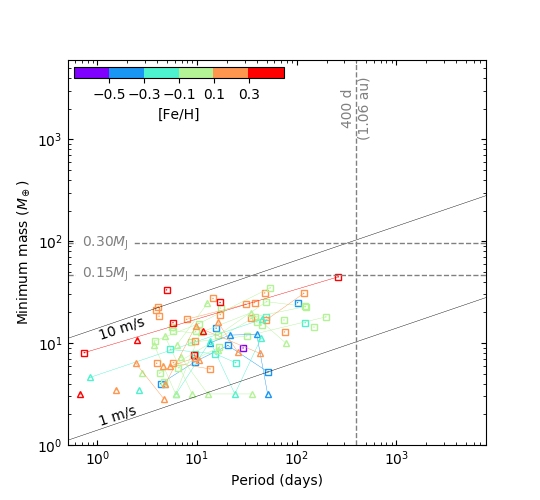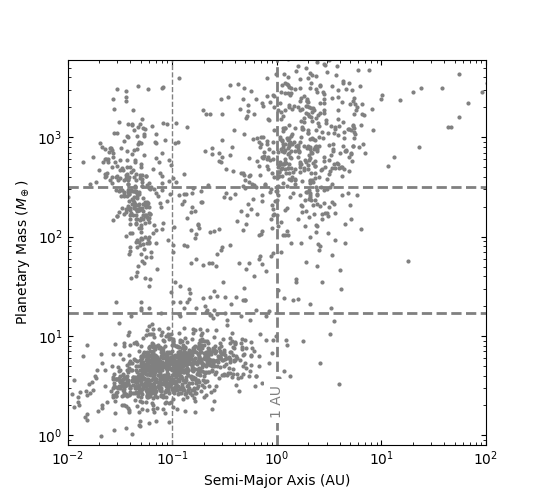Kepler systems do not show intrinsic intra-system uniformity
Wei Zhu (祝伟)
Canadian Institute for Theoretical Astrophysics
Extreme Solar System IV
2019-08-22, Reykjavik

Intra-system uniformity
- Lissauer et al. (2011): Adjacent Kepler planets tend to have similar sizes.
- Ciardi et al. (2012): The outer planet is preferentially larger than the inner one.
- Weiss et al. (2018): Inter-system variation > intra-system variation \(\rightarrow\) Kepler multi-planet systems are like "peas in a pod."
- Millholland et al. (2017): Planets in the same system should also have similar masses.

Image from Lissauer et al. (2011)
Outer-to-inner radius ratio
Outer planet larger
Inner planet larger

0.4 \(R_\oplus\)
0.9 \(R_\oplus\)
1.0 \(R_\oplus\)
0.5 \(R_\oplus\)
11 \(R_\oplus\)
9 \(R_\oplus\)
4.0 \(R_\oplus\)
3.9 \(R_\oplus\)
Do Solar system planets show
size (or mass) similarity?
- No, if knowing all planets
- Giant planets are not observable: orbital period too long
- Mercury & Mars undetectable: too small
- Yes, if only Venus & Earth are seen
Intra-system uniformity:
intrinsic or observation bias?
- Do they have outer (\(\gtrsim 1\) au) giant planet companions?
- Are there smaller undetectable inner (\(\lesssim 1\) au) planets?
Cold Jupiters
Super Earths

22 from Kepler (triangles) + 39 from RV (squares)
(see also Bryan et al. 2019, Herman, Zhu, & Wu 2019)
Super Earth-cold Jupiter correlations
Cold Jupiters
Super Earths

22 from Kepler (triangles) + 39 from RV (squares)
-
1/3 of Kepler systems have cold Jupiter companions.
- >50%, if [Fe/H]>0.
(see also Bryan et al. 2019, Herman, Zhu, & Wu 2019)
Super Earth-cold Jupiter correlations
Cold Jupiters
Super Earths

22 from Kepler (triangles) + 39 from RV (squares)
-
1/3 of Kepler systems have cold Jupiter companions.
- >50%, if [Fe/H]>0.
- Cold Jupiters (almost) always have inner super Earth companions!
(see also Bryan et al. 2019, Herman, Zhu, & Wu 2019)
Super Earth-cold Jupiter correlations

Miranda Herman
HATNet
Keck

Cold Jupiters
(~10%)
Cold Neptunes






- Most Kepler-like planetary systems have outer giant planets.
- Almost all cold giant planets have inner small planets.
- Intra-system size and mass similarities no longer hold.
Kepler-like systems frequently have
outer giant companions
-
Do they have outer (\(\gtrsim 1\) au) giant planet companions?
- Most of them do.
-
Are there smaller undetectable inner (\(\lesssim 1\) au) planets?
- Does dynamical stability allow for undetectable small planets?
- Is there sign for such planets?
Intra-system uniformity:
intrinsic or observation bias?
Does dynamical stability allow for undetectable small planets?

- Yes, even for high-multiples (\(\geq 4\)).
- Even less an issue for 2-tranet & 3-tranet systems, which contribute >80% of Kepler multi systems.
From Weiss et al. (2018)
Is there a sign for smaller undetectable planets?
Noisy sample
Quiet sample
Data from Weiss et al. (2018)
- The sample S/N cut corresponds to different radius thresholds for different stars.
CDPP CDF

From Ciardi et al. (2013)
-
Kepler detections pile up toward the
detection threshold.




On the apparently similar sizes
Correlation strength \(r\)
Forward modeling
A more proper way is fully forward modeling the detection and selection processes from the intrinsic planetary (radius or mass) distribution. Instead of randomly drawing parameters from the observed distribution, one should draw from the intrinsic distribution and then apply the same detection criteria (e.g., S/N cut) on these simulated planets. This process requires knowing the intrinsic planet distribution function and having access to the automated Kepler detection pipeline. It is further complicated by the fact that the planet distribution function is period dependent (e.g., Dong, & Zhu 2013; Hsu et al. 2019) and possibly multiplicity dependent, and that the Kepler detection efficiency is weakly multiplicity dependent (Zink et al. 2019).
There is a shortcut that circumvents these problems. As it is the transit S/N that determines whether or not a planet is detected, we can simply start from the observed S/N distribution.
Why resampling S/N makes sense?
Page 2 of Zhu, arXiv:1907.02074
Period ratio of inner pair
Period ratio of outer pair
Stability
boundary
- Kepler multi-planet systems are dynamically compact (Pu & Wu 2015).
- Stability boundary (measured in period ratio) shifts to smaller value as planet radius decreases.
Systems around
- noisy stars
- intermediate stars
- quiet stars.
On the apparently regular spacings
Period ratio of inner pair
Period ratio of outer pair
- Kepler multi-planet systems are dynamically compact (Pu & Wu 2015).
- Stability boundary (measured in period ratio) shifts to smaller value as planet radius decreases.
Systems around
- noisy stars
- intermediate stars
- quiet stars.
On the apparently regular spacings

- Weiss et al. (2018) cut at Period ratio=4.
- Detection bias & dynamical stability.
Data used in Weiss et al. (2018)
All planet triplets
On the apparently regular spacings
Summary
- In (super) Kepler's eye, Solar system planets would show size/mass similarity, even though they do not intrinsically.
- Do Kepler planets have outer giant planet companions?
- Most of them do (Zhu & Wu, 2018; Herman, Zhu, & Wu, 2019).
- Are there smaller undetectable inner planets?
- Does dynamical stability allow for undetectable small planets?
- Yes, even for high-multiples.
- Is there sign for such planets?
- Yes. Kepler detections pile up toward detection threshold (set by S/N).
- Does dynamical stability allow for undetectable small planets?
- The sample S/N cut corresponds to different radius thresholds for different stars (Zhu, arXiv:1907.02074).
Q: Do planets show intra-system uniformity intrinsically?
back up slides
Period ratio of inner pair
Period ratio of outer pair
Stability boundary
Noisy stars
Intermediate stars
Quiet stars